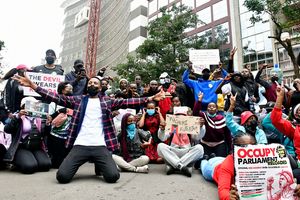
Police officers arrest a protester in Nairobi during anti-Finance Bill demos on June 25,2024.
A special team drawn from the National Intelligence Service (NIS) and the Directorate of Criminal Investigations (DCI) is behind the abductions targeting activists and influencers with massive following on social media.
This team, the Daily Nation has learnt, was formed on Sunday following a high-level security meeting in Nairobi.
Also incorporated in the squad are officers from other specialised agencies like the Anti-Terror Police Unit.
With hours to the start of the protests, the team of heavily armed operatives – mostly in plainclothes that is led by a former DCI operative now in the NIS – went into action.
Also in this squad are selected individuals from the DCI Operation Action team based at the DCI headquarters.
The squad has technical support from NIS experts who have been monitoring the social media accounts of people believed to be influential or have mass following.
According to a source familiar with the operations, once the IT team in Ruaraka has identified an influencer, he or she is placed under surveillance.
Their social media accounts and mobile communication are monitored. The technical team then forwards the details of the possible target to this squad.
The surveillance, including the old-fashioned physical trailing, is used to track the target before the officers pounce at the opportune moment.
Squad members, who operate discretely from DCI headquarters on Kiambu Road, have seized some activists outside premises with security cameras deliberately to instil and spread fear in potential protesters.
Sources familiar with the operations say the squad has been using hired vehicles to avoid attracting public attention.
Planning and financing
The sources said once individuals believed to be holding key information on the planning and financing of the demonstrations have been seized, they are driven around the city as they are quizzed.
The detainee is blindfolded, with the officers openly speaking about eliminating them.
After being driven around, some detainees are locked up in safe houses run by the intelligence units where interrogation continues. One of these houses is in Muthaiga, Nairobi.
The information being sought by the interrogators includes communication on the planning of the demonstrations, the leaders and financiers of the protests.
Some of those arrested were taken to police stations, from where lawyers secured their release.
At least 12 individuals have been abducted by state agents but sources say the interrogations have not yielded fruits.
By Saturday night, hours after Inspector-General of Police Japhet Koome and other security chiefs briefed President William Ruto on the state of the country, the government had not cracked the planning of the demonstrations.
Authorities also have problems with the idea of the protests not having a clear and recognisable leadership.
Despite efforts to crack down on the marches, state operatives are yet to establish if the protesters have been receiving funding from external forces as claimed by Government Spokesman Isaac Mwaura.
Last evening, a source familiar with the operations said those still in detention would be freed unconditionally.
Another source blamed “frosty” relations between the police and the intelligence leadership for failing to infiltrate and break up the protests.
“The National Police Service leadership and the NIS are not reading from the same script in dealing with the situation. The IG may not even be aware who is being held where,” the source said.
Confusion
The Sunday Nation reported the confusion and crises in the government undermining efforts to contain the protests.
Sources familiar with the events at the Police headquarters told the Daily Nation that Mr Koome and his commanders had not crafted an operation manual to counter the protests.
Key meetings that are traditionally held by the IG and his commanders in the middle of a crisis had not taken place less than 24 hours before the protesters poured into the streets.
The operation order agreed by the police top brass is then cascaded to the officers on the ground.
A source said things are so bad that an operation order that was used by Nairobi police during anti-government protests orchestrated by the opposition last year is guiding the handling of the latest marches.
Mr Koome denied claims that the operation order used to curb the protests last week was outdated.
“We have an order guiding this operation,” Mr Koome said.
He then added that police would not allow protesters to access Parliament or any other critical government office.
On Tuesday, the protesters stormed Parliament and burnt a section of the heavily fortified building. Police fired back, killing several.
Mobs raided properties belonging to MPs who voted for the bill across the country.





